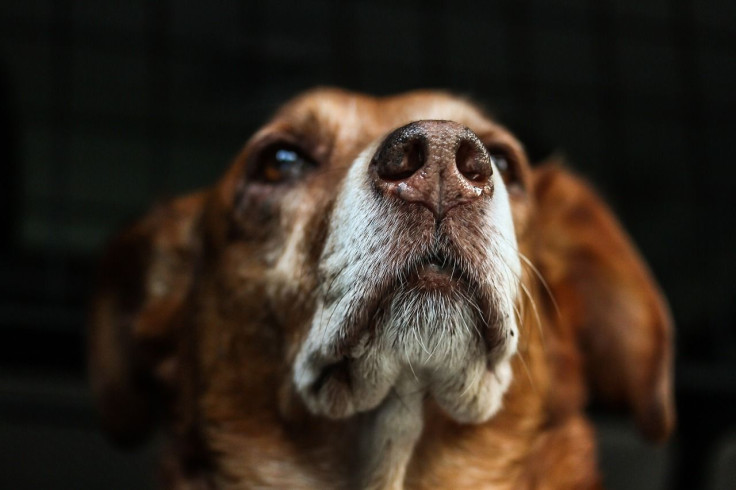Siccing the Dogs on Covid-19

The hero of this story spent most of the interview lying on the ground. In fact, he didn't say a word.
Toby is a working dog at the Penn Vet Working Dog Center (WDC), run out of the University of Pennsylvania's School of Veterinary Medicine in Philadelphia.
"A dog's sense of smell is excellent," said Jennifer Essler, PhD, a postdoctoral fellow at the WDC. It is so good, in fact, that dogs are being trained to detect COVID-19. The Penn veterinary school is working to create a team of dogs to sniff out COVID-19.
Toby is not part of the COVID-19 work. He is, however, able to find the eggs of the spotted lanternfly, an invasive bug, said Dr. Essler, who is Toby’s foster mother and handler.
Work like a dog
"[Dogs have] as many as 250 million receptor cells in their nose for odors,” Dr. Essler told Medical Daily in an interview.
Where does that put humans compared to dogs? "Humans have between 5 and 10 million, so it's an order of magnitude much larger, and [dogs] also have a larger part of their brain dedicated to processing odors," she explained.
"I mean, dogs have a great nose. That's not a question. But dogs don't have the best nose in the animal kingdom,” Dr. Essler. If the only job qualification were nose quality, she would suggest an elephant or a bear. But a bear is probably not the best job candidate for much of the work sniffer dogs do. Waiting in line at the airport is never fun, but it would be far less fun, and downright dangerous, if a bear were in line with you.
Every dog has his day
Just like people, not all dogs are suited for every job. And as with people, job fit is essential.
"Some dogs are sporadic and fast, and they want to run around really quickly, and those aren't the dogs that are going to find these tiny little spotted lanternfly eggs," said Dr. Essler, referring to Toby’s assignment. As for those high-energy dogs, "they might be the dogs that go and find victims in search-and-rescue scenarios," she said. "It's not usually their nose that holds them back, it's their behavior, it's their personality."
Personality isn't the only advantage working dogs have. Working dogs are also man's best friend. The dogs trained by WDC not only find smells, but they alert their handlers.
"The cool part about dogs is you can train them to find it, and then [they] tell you they found it," said Dr. Essler. "It's that relationship with the people that kind of makes them fill this really special niche in finding hidden odors for us in lots of different detection capacities."
You can teach an old dog new tricks
Training dogs to sniff out COVID-19, often detected in human sweat, does not happen overnight. Handlers need to train dogs not only in "nose work" etiquette but also to detect COVID-19 specifically. Although people at home can train their dogs to do some nose work, the WDC trains dogs to be expert at detecting a specific target odor, be it explosive, drugs or medical discrepancy. Dogs from the WDC can also smell out ovarian cancer; chronic wasting disease, found in deer; and antiquities, ancient pottery and cultural relics.
How does a dog detect COVID-19?
The WDC dogs are trained using samples of urine and saliva from COVID-19 positive people. What the dogs smell are volatile organic compounds, or VOCs. All kinds of things emit VOCs, and diseases can be detected through VOCs in blood, urine, feces, sweat and really anything else the body emits or secretes. Although some VOCs are imperceptible to the human nose, The Journal of Biochemistry recounts cases when even humans could identify these smells. People with diabetes who are in ketoacidosis, a serious complication of diabetes, occasionally have breath that smells of rotten apples, while people with typhoid fever can have a musty, yeasty smell. It's not yet known what smell dogs might detect in COVID-19 positive cases, but researchers in Germany found that dogs had a 94% success rate.
"The potential impact of these dogs and their capacity to detect COVID-19 could be substantial. This study will harness the dogs’ extraordinary ability to support the nation's COVID-19 surveillance systems, with the goal of reducing community spread," said the center’s director Cynthia Otto, DMV, PhD, in a press statement.
It is unlikely anyone will be greeted by a professional COVID-19 sniffing dog any time soon in the U.S. The University of Pennsylvania study is still in progress, but its outcomes could make a huge difference in the future.
Published by Medicaldaily.com



























